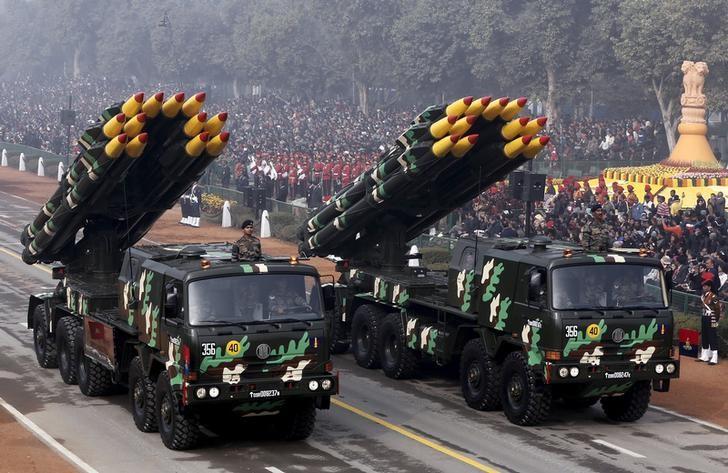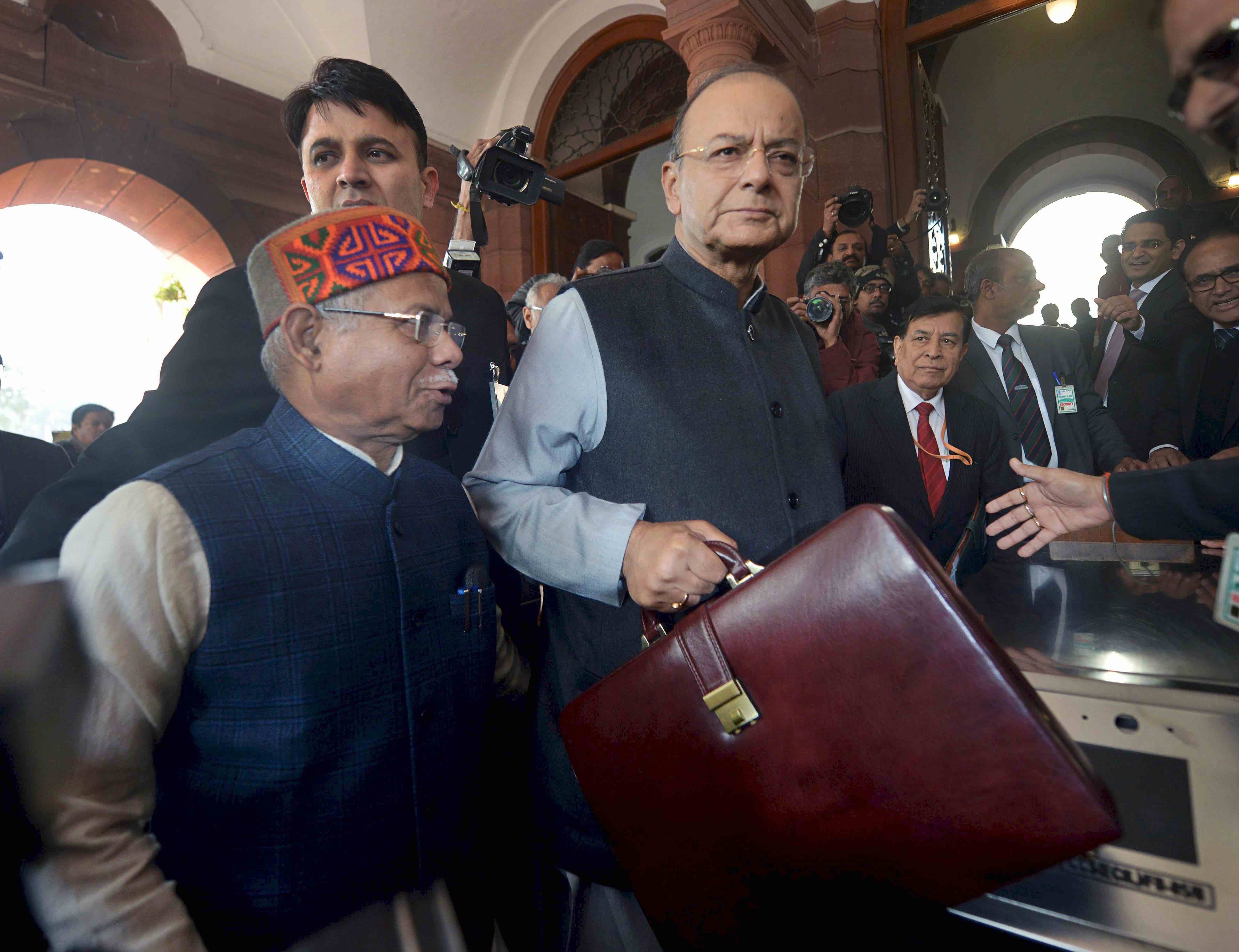There is no dearth of ideas on how the defence ministry’s capital account can be fully utilised – only a lack of will.

Indian army officers stand on vehicles displaying missiles during the Republic Day parade in 2016. Credit: Reuters/Altaf Hussain
Ironically, the most mundane and least discussed component of the finance minister’s annual Budget speech is defence. As its long-time monitor and critic, it is distressing for a veteran of wars and insurgencies to have to say this. A nation that does not allocate sufficient acumen and resources to defence of the realm and pretends to be ready to face a two-front war had better watch out.
That said, as in the past, defence did not feature at all in any of the myriad discussions on the electronic media on defence budget. Like last year, it was only the former editor of Business Standard, A.K. Bhattacharya , who quizzed Finance Minister Arun Jaitley on Doordarshan on the budget, including on defence. Last year, he had asked: “There is criticism that you haven’t done enough for defence’’ Jaitley replied: “If the defence ministry can speed up its acquisition mechanism, they can get as much money as they want. Budgetary allocations are only indicators: defence gets the highest priority…”
Last week, Bhattacharya asked Jaitley that given the geopolitical conditions on the Indian sub-continent, could you not have allotted defence a little more? It was essentially the same question as last year, but re-worded. Jaitley’s reply, however, was different this time round.
He said: ‘’I certainly believe that defence needs more money. This is catch-22 situation, given the amount of revenue that you get…’’and then he went off on a tangent on GST and income tax collections, suggesting “I would be only too willing to make available for defence whatever extra is required, if I had more.”
Notably identical questions in his successive interviews elicited different responses. In the first case, Jaitley said that as defence can’t spend the allocation, why give more. In the latter instance he said: “I’m ready, provided I have the resources.” This ‘more’ money refers to the capital account for modernisation.
Also read: In Defence Budget 2018, Political Goals Masquerade as Military Objectives
In an interview to the Hindustan Times on February 4, the finance minister expressed an inability to provide more for defence saying: “I would have loved to…but it is the size of the cake…or I enlarge the fiscal deficit.” Human rights activist Aakar Patel says there was no mention of defence in Jaitley’s Budget speech because it carries severe cuts.
It is widely known that despite having been defence minister twice, Jaitley is not particularly sympathetic to defence. In 2016, in his mid-term fiscal policy speech, he had said defence expenditure for 2017-18 and 2018-19 will be 1.6% of GDP. He has kept his word. His Budget allocations confirm his forecast. In his first full Budget speech, he skipped mentioning defence altogether with allocations traceable in the expenditure account. This year, he commended the defence forces for the great work they do and mentioned the core responsibility of the defence budget – operational preparedness and modernisation while also mentioning self-reliance. There was also a reference to defence production, defence corridors and strategic tunnels in the border areas, but Jaitley skipped indicating monetary allocations altogether. As Patel had feared.
The meagre increase in capital account was not worth mentioning, notwithstanding the swelling salaries and pensions under the revenue head. The key achievement of last year’s defence budget was the almost unprecedented full utilisation of the capital account. No money was surrendered as in the two previous years which was worth Rs 18,000 crore. It is this problem that Jaitley cited for not allotting additional capital funds to defence in his first interview to Bhattacharya.
Shorn of statistics, the highlights of this year’s defence budget are five-fold. One, full utilisation of the previous year’s capital allocation. Two, the pension bill exceeding the capital account. Three, a progressive decline in defence expenditure as a percentage of government spending. Four, a systematic decline of the defence budget as overall percentage of GDP to the lowest 1.57%, even less than in 1962. And finally, five, slow or no progress in self-reliance and Make in India.
At the heart of the defence budget is capital expenditure – which accounts for operational preparedness and modernisation. When former Army chief General V.K. Singh in 2013 referred to the ‘critical hollowness in defence’ , he was talking about war preparedness. Only scant improvement can be reported in this area. Besides inadequate allocation of capital expenditure, the key stumbling block is the several times revised new defence procurement procedure, whose central theme is probity. Single-vendor situations and blacklisting of defence companies have killed several projects and, therefore, reliance on government-to-government contracts which rob them of any competition. The defence bureaucracy and the ministry are so petrified of any slip ups – especially after a former Air Chief was locked up on allocations of fraud – that probity trumps operational preparedness.
Also read: Defence Budget 2018: The Proof of the Pudding Is in the Eating
This year, the capital allocation is Rs 99,563 crore. But this amount is not meant for new guns, ships and aircraft for the services alone, as it covers expenditure for Defence Research and Development Organisation, ordnance factories, land and construction and other miscellaneous heads, leaving the Army, Navy and Air Force with no money to undertake new projects. Also 60% of the annual allocation goes towards committed liabilities – of old projects like 36 Rafale aircraft, six C130 J transport aircraft, AKH 64 attack helicopters and M777 ultra light Howitzers. A lot of jugglery is done with figures. Last year, capital funds had to be transferred to revenue to meet increased salary bills on account of the 7th Pay Commission. Experience has shown that nine out of 10 times, capital expenditure has had to be returned unutilised. A notable exception is last year.
Parliamentary standing committee reports steered by BJP stalwart General B.C. Khanduri has produced reams on delays resulting in the surrender of capital funds. Among other deficiencies, its reports (number 35 and 36 of 2017) state that “India is not combat-ready, armed forces under-equipped and procurement policy and procedures, inadequate”. There are battles going on between ministries of finance and defence and the armed forces. A number of reasons are given for delays, underutilisation of capital and its surrender. A former defence secretary has candidly admitted that at times, the finance ministry would ask for ‘X’ thousand crores to be returned to tweak the fiscal deficit.
The reason cited by Jaitley last year for not making higher allocation in capital account was the inability of the defence sector to absorb the capital allocation. A number of studies have suggested ways and means of overcoming the impediments to full utilisation of funds. A committee headed by Pritam Singh had suggested an independent organisation outside the ministry of defence for defence acquisitions.
Now, policy think-tank Pahle India Foundation has recommended the appointment of an independent regulator who will “force all decision-making entities including the Cabinet Committee on Security to work out an acquisition plan commensurate with funds allotted.”
In 1988, when I was with the Defence Planning Staff, we had recommended the formation of a Defence Acquisition Command and introduction of the Plans and Programmes Budgeting System for defence planning. The British conduct defence and national security capability review and based on it the defence modernisation programme.
Apparently, there is no dearth of ideas. Capital account can be spent as demonstrated last year. To meet a two-and-a-half front challenge (war) you need to find more monies from the ‘’cake’’ and spend it in full. In other words, as former British Prime Minister Margaret Thatcher’s said, ‘if there is a will, there is a way’.
Major general (Retd) Ashok Kumar Mehta is a founder member of the Defence Planning Staff, the forerunner of the present Integrated Defence Staff.

